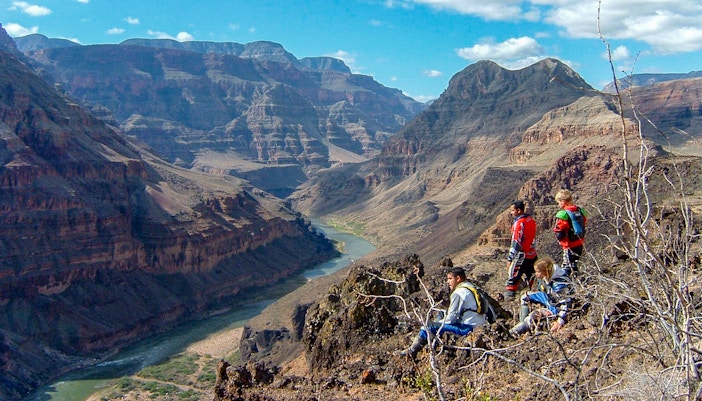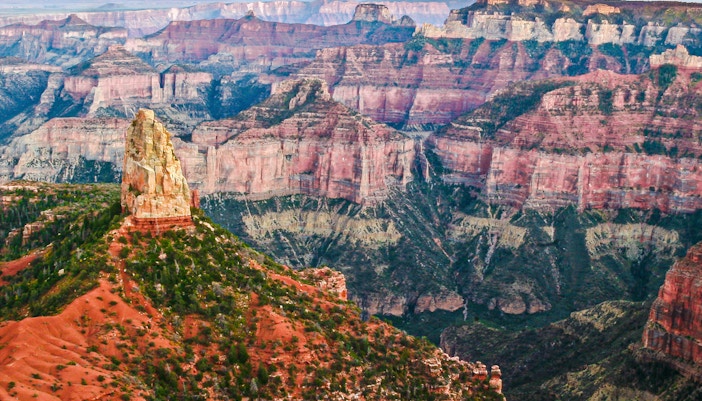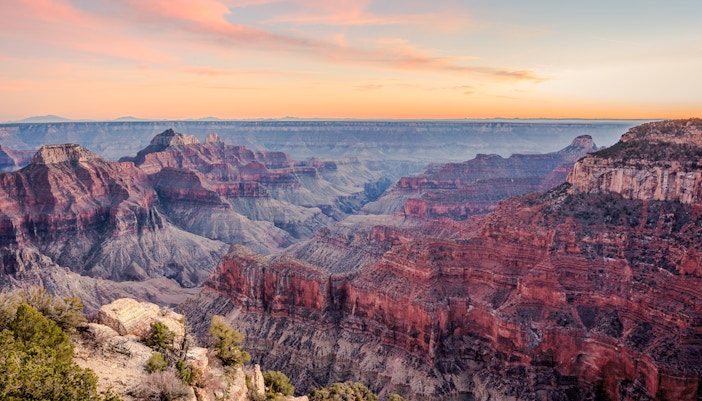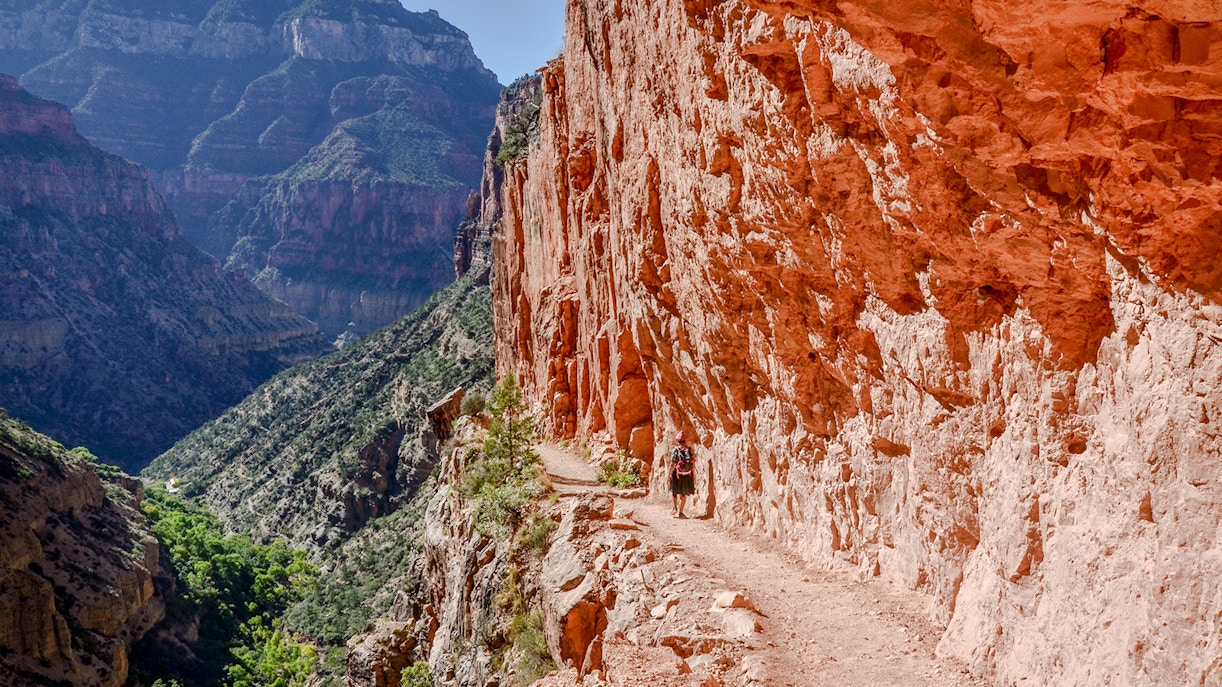
- Grand Canyon
- History
- Wildlife
- Photos
- Viewpoints
- Shoshone Point
- Yavapai Geology Museum
- Things to Do
- Hermit's Rest
- Camping
- Hiking
- Grand Canyon Village
- Weather
- Hopi House
- Plan Your Visit
- Timings
- Directions
- Entrances
- Restaurants
- Facts
- Map
- Itinerary
- Grand Canyon Railway
- Hotels
- Rim to Rim
- Shopping
- Grand Canyon Helicopter Tours
- West Rim Skywalk
- Grand Canyon West Rim Helicopter Tours
- Grand Canyon National Park Tours
- Grand Canyon Hummer Tours
- Grand Canyon Airplane Tours
- Grand Canyon Tours
- Grand Canyon National Park Helicopter Tours
- Grand Canyon Boat Tours
- Las Vegas to Grand Canyon Helicopter Tours
- Grand Canyon West Rim Tours
- Grand Canyon Tours from Las Vegas
- Grand Canyon North Rim
- Grand Canyon South Rim
Grand Canyon North Rim | All you need to know about the “other side”
Why go on a Grand Canyon North Rim tour

Fewer crowds, more peace
Unlike the South Rim, which sees millions of visitors a year, the North Rim hosts just a fraction of that. You’ll get wide-open views without elbowing for a photo, and hiking trails that feel genuinely remote.

Cooler temperatures in summer
Thanks to its elevation (over 8,000 feet), the North Rim stays cooler than the South Rim. That makes it a great choice if you’re visiting in summer and want to avoid the desert heat.
Find out more about Grand Canyon's weather
Unique wildlife
The North Rim is the only place where you can spot the Kaibab squirrel. You might also see bison, which roam the open meadows nearby. Bring binoculars and a bit of patience.
Species of wildlife you'll spot at the canyon
Unfiltered canyon views
With fewer safety railings and commercial development, the North Rim feels wilder. Viewpoints like Cape Royal and Point Imperial offer dramatic views with little between you and the horizon.

Easy day trips from Las Vegas
If you’re short on time, airplane tours from Las Vegas make the North Rim accessible in a single day. Some packages even include hotel pickup, guided stops, and a chance to see the Hoover Dam or Lake Mead along the way.
Find all aerial tours from Las VegasYour tour options explained

Airplane tours
These typically depart from Las Vegas and include scenic flights over iconic landmarks like the Hoover Dam, Lake Mead, and the Colorado River. Many packages also feature ground-based excursions upon landing, such as Polaris Ranger rides or ATV adventures, plus a hearty barbecue lunch at Bar 10 Ranch. These tours offer a well-rounded blend of aerial sightseeing and rustic canyon exploration.
Recommended tickets:
90-min Las Vegas to Grand Canyon North Rim Airplane and Ground Tour

Helicopter tours
These are ideal for those who want a quick but immersive canyon experience. You’ll fly over both the North and South Rims, witnessing geological wonders like the Vishnu Schist and Dragon Corridor from above. Some packages offer an optional Hummer tour for further exploration of the South Rim, either by day or at sunset.
Recommended tickets:
25-min Grand Canyon National Park Helicopter Tour with Optional Hummer Tour
What to do at the North Rim

Scenic drives and viewpoints
Drive the 23-mile Cape Royal Scenic Road, a winding route lined with pullouts that lead to jaw-dropping canyon views. Stop at Cape Royal Point for one of the widest panoramic views on the North Rim, complete with picnic areas. Don’t miss Point Imperial, the highest viewpoint in the park, where you’ll see the Painted Desert stretching to the horizon. A short walk from Cape Royal takes you to Angels Window, a natural rock arch that frames the Colorado River far below.

Hiking trails
Try the paved Bright Angel Point Trail, just half a mile round trip, for sweeping canyon views within easy reach of the Grand Canyon Lodge. The Transept Trail winds gently through forests of aspen and pine and connects the Lodge to the North Rim Campground. Up for a challenge? The North Kaibab Trail is the only path from the rim to the river and requires a demanding hike to the stunning inner canyon scenery. Other options include Cliff Spring Trail, Ken Patrick Trail, and adventurous treks to Ribbon Falls and Deer Creek Falls.

Climb the North Rim Lookout Tower
For a panoramic view that stretches across forested plateaus and the canyon’s rugged depths, head to the North Rim Lookout Tower. Perched above the tree line, this historic fire tower offers a unique vantage point. Fun fact: it was originally built to spot forest fires in the Kaibab National Forest.
Plan your visit

The North Rim is open seasonally from May 15 to October 15, with visitor services operating daily from 8 am to 6 pm. This limited window is due to snow and weather conditions in winter, so planning your visit during the warmer months is essential.

The North Rim is more remote than other areas of the Grand Canyon, which is part of its charm. Highway 67 is the only access road, and it closes in winter. There’s no airport nearby; Kanab, Utah, is the closest at about 2 hours’ drive. Services like the Trans-Canyon Shuttle connect the North and South Rims during the open season for those without a car.
Address: North Rim Visitor Center, AZ-67, North Rim, AZ 86023, United States | Find on Maps
The entrance to the North Rim lies 30 miles south of Jacob Lake, Arizona, along Highway 67. From there, it’s another 14 miles to the actual rim where scenic viewpoints and the Grand Canyon Lodge are located. Jacob Lake sits in northern Arizona along Highway 89A, close to the Utah border.

- Stay on designated trails and viewpoints to protect the environment and ensure your safety.
- Do not feed, touch, or approach wildlife under any circumstances.
- Drones are strictly prohibited within Grand Canyon National Park.
- Campfires are only allowed in designated fire rings and may be restricted during fire season.
- Pets must be leashed at all times and are only allowed in developed areas.
- Pack out all trash, including food scraps, to help keep the park clean.
- Observe quiet hours in campgrounds from 10pm to 6am to respect other visitors.
Book Grand Canyon tours
Frequently asked question about the North Rim
The North Rim is open seasonally from May 15 through October 15 each year. It is closed during the winter months due to snow and limited road access.
The North Rim is quieter, cooler, and more remote than the South Rim. It offers lush pine forests, fewer crowds, and elevated viewpoints with dramatic canyon vistas.
There’s no airport at the North Rim. Most visitors drive from cities like Las Vegas, Phoenix, or Salt Lake City using a combination of highways, including Highway 89A and Highway 67.
Yes. You can book airplane or helicopter tours from Las Vegas that include aerial views and ground excursions to the North Rim, often with hotel transfers and meals included.
Yes. Trails range from easy walks like Bright Angel Point Trail to challenging hikes like the North Kaibab Trail, which descends to the Colorado River.
Absolutely. The North Rim offers easy scenic drives, family-friendly hikes, wildlife spotting, and ranger programs, making it a great option for visitors of all ages.